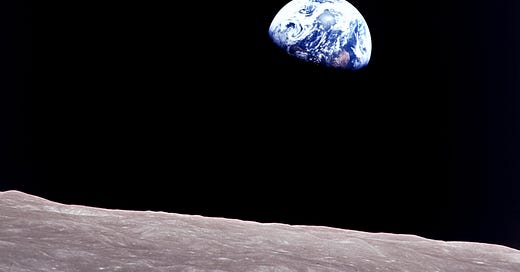William Anders left one of our most iconic views of our world in one simple photograph. You remember: the one of half of the blue orb, swathed in white swirling clouds, floating in the middle of unending blackness. Sure, the foreground of the shot is the surface of the moon, but that was a place we had yet to touch when he took the photograph on Christmas Eve 1968. The photograph absolutely lures one, even fifty- five years later, to the untethered and vulnerable sphere.
Most of you are not old enough to remember but I most certainly do recall how profoundly this single photograph impressed us as humans. Anders’s spur of the moment shot, one which transcripts indicate was ‘not on the program’ so not a guarantee by any means, was our first reminder how isolated, how unique, how self-contained our lives.
Earthrise, as it became known, single-handedly sparked the Earth Day movement which began in 1970. Sure, the 60s generation had voiced interests in preserving the deteriorating planet but the photograph provided even more purpose to that movement. Two months ago, we celebrated the 54th Earth Day.
What strikes me about this photograph is how completely different we are as a society today. I remember no cries of ‘fake news’ at the sight of this precious world, though there were muted voices about Neil Armstrong’s moon walk later. People did not divide into partisan attacks on NASA or Andrus or someone else. We actually had a muted sense of national pride, even when people did not want to credit LBJ with anything positive. The nascent environmental movement has always had fans and opponents but vitriol was absent. We didn’t have to fear the Russians on this one as our astronaut had snapped the exposure when we were fulfilling JFK’s 1962 challenge to go to the Moon ‘in this decade’ as his pronunciation emphasised.
In fact, the world was fascinated that NASA successfully made it to the Moon. The 1968 Apollo 8 mission was the first to circle the Moon, going where no one had ever gone befoe to the dark side of our satellite. Andrus, James Lovell, and Frank Borman made their trip on Christmas Eve, assuring the world of ‘good news’ as it held the world with rapt attention.
Indeed, the flight occurred as the world closed a year of massive discontent. Martin Luther King and Bobby Kennedy both died at the hands of assassins in 1968, the former days after LBJ surprisingly withdrew from his reelection campaign. Thousands died in Vietnam as the war dragged on. Riots in Paris and student protests in Mexico challenged their governments. The Mexico City Olympics included Black Power salutes. Richard Nixon won election after the Chicago convention fiasco. The world we knew seemed, in sum, to be disintegrating, to the joy of some and panic of many.
NASA’s Apollo 8 proved we could get to and travel around the moon successfully. Seven months later Neil Armstrong and Buzz Aldrin walked on the surface of that sphere, again mesmerising virtually anyone alive at the time.
We don’t go to the Moon any longer, although I heard last week following the Boeing-NASA joint launch that we are returning to space. NASA is one of the countless federal agencies increasingly starved for funding as our budget allocates ever more to pay the burgeoning debt payments. I am unsure that many Americans would believe we were in space, anyway, since the partisanship defaults to attacks on any evidence the Government provides for half of the country.
William Anders died last week, piloting a plane that crashed near Seattle. He was 90, reminding us that not only is the D Day generation passing but the founding astronaut corps is largely gone.
Anders’s immortal shot, however, remains for us to admire, to cherish, and the ponder. Actions create consequences so Anders’s spontaneous click of a camera is, as the photographer Galen Rowell noted, the single most influential ever. Talk about an impact.
I appreciate your time reading ACC today and any day. Please send me any reactions, thoughts, concerns, or rebuttals. If you find this of value, please feel free to circulate it. Thank you deeply to those who with a subscription. If you value this work, I hope you will consider investing in this work.
Be well and be safe. FIN
William Anders, ‘NASA Earthrise’, retrieved at https://solarsystem.nasa.gov/internal_resources/3271/
JFK retrieved at
Ginger Adams Otis, ‘William Anders, former Apollo 8 Astronaut who took ‘Earthrise’ Photo, Dies in Plane Crash’, WallStreetJournal.com, 7 June 2024, retrieved at ‘https://www.wsj.com/us-news/william-anders-former-apollo-8-astronaut-who-took-earthrise-photo-dies-in-plane-crash-5f3921d7?mod=Searchresults_pos2&page=1




